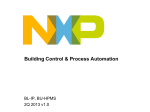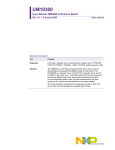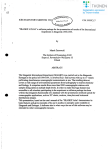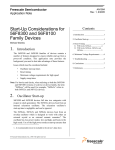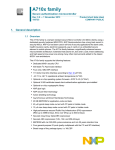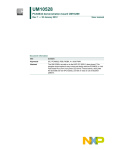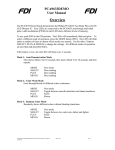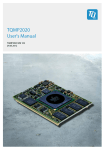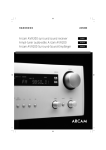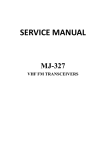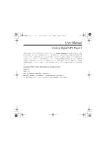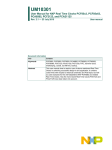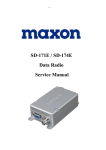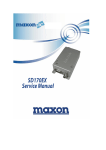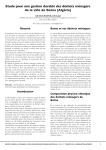Download Solar PV System Applications
Transcript
BLIP Solar PV System Application BL-IP, BU MMS Q1 2012 Overview Solar PV Energy may achieve grid parity before 2015 – Prices of the modules have plummeted from $3.50/watt in 2008 to $1.43/watt today (GTM Research) – Fuel prices are consistently increasing since 2008 – Solar Electric Energy demand has grown by an average 30% per annum to 40GW over the past 20 years against a backdrop of rapidly declining costs and prices. New Safety regulations – Arc detection become mandatory in USA (2011) - Regulation NEC 690.11 Arc-Fault Circuit Protection requires any PV system with DC circuit operating at 80V or greater need to be protected by Arc Fault Circuit Interrupter – Firefighter Association in Germany: Requires active control switch for fire-fighter to shut-off solar panels in case of fire Green Energy Benefits & Awareness – Struggling with a continuing nuclear crisis and strains on its power supplies, Japan is thinking of requiring that all new buildings, including homes, come equipped with rooftop solar panels by 2030, according to a recent Nikkei newspaper report. 2 Types of Solar Systems DC-off grid residential utility off-line domestic commercial power plant <2kW <10kW 10kW-2MW >>MW off-grid grid connected @ demand side w/ battery w/ and w/o battery supply side 3 Factors driving electronics in Solar Panels Maintenance – Isolating faulty panels for early replacement System Performance Monitoring – Accurate view of energy production – Monitor effect of environmental conditions in power generation – Theft protection (digitally lock, alarm or „immobilize‟ stolen modules) NXP Solar Panel Controller and Active Fire Safety Switch Reference Design Safety – Fire-fighter Safety – Arc Fault Detection Separate solution 4 Solar PV System Block Diagram NEW Solar Panel Monitoring Reference Design Communi cation Communi cation Communi cation Panel Electronics Wired and Wireless Interface Inverter/Controller NEW PV Inverter Arc fault Detection Circuit Concept 5 Solar PV Panel Block Diagram LED Status indicator Received Signal Strength Indicator (RSSI) – Arc Detection Communication Voltage Level Translators I2C Bus Buffers Microcontroller UARTs & Protocol Bridges Proprietary RF/IF System I2C GPIOs Power Line Modem Temp sensor 6 Solar Inverter / Charge Controller Block Diagram LED Status indicator Received Signal Strength Indicator (RSSI) – Arc Detection Communication Ethernet Voltage Level Translators Microcontroller I2C Bus Buffers UARTs & Bridges Proprietary RF/IF System I2C GPIOs Power Line Modem Energy Meter LCD Monitor Real Time Clock Temp sensor Power Metering To Grid / Home Network INVERTER 7 Power Line Modem 8 TDA5051A Power Line Modem Features: Low cost solution and easy assembly with SO16 plastic package ASK Power Line Modem operating up to 1200 bps 5V supply voltage Carrier frequency set by clock from micro controller or on-chip oscillator Automatic gain control of receiver input & power overload protection transmitter output 8-bit A/D and narrow digital filtering Easy compliance with EN50065-1 with simple power line coupling networks Benefits: Low cost digital PL modem solution NXP software support Robust solution with zero cross detection and redundancy protocol In Production 9 UARTs & Bridges 10 I2C/SPI/UART Protocol Bridges Value Proposition Where Used? New generation of interface solutions for managing communication among various bus interfaces The purpose is to overcome the limitations of the host bus interface to the peripherals UART I2C I2C SPI IrDA SPI Why Used? UART GPIO Greater design flexibility Ability to retain original design investment Faster time to market Link legacy and new systems and vice versa Why NXP Bridges? Wide portfolio of I2C/SPI/UART Bridges to choose from. 11 SC16IS75x/76x : I²C/SPI to UART Bridge Microcontroller NXP SC16IS752 Bridge IC UART / IrDA I2C / SPI Master Minimal connection I2C / SPI Slave Speed up to 5Mbps Bluetooth Module Bluetooth Laptop CH A UART / IrDA CH B GPIO Enhance your connectivity to fully-featured serial interfaces: without the hassle! Remote Control LED Advantages: -2.5V or 3.3V Operation -64-byte FIFO -Baud rate up to 5Mbps -Auto HW and SW flow controls -Built-in IrDA SIR -Up to 8 programmable GPIO -And more In Production 12 SC18IS600: SPI-to-I2C Host / CPU SPI Master SPI Bus I2C Slave Devices SC18IS600 SPI Slave I2C EEPROM (PCF85116) I2C Master I2C LED Dimmer (PCA9531) 5 GPIOs I2C GPIO (PCA9554A) Peripherals Host / CPU I2C Master LEDs, Swicthes I2C Bus In Production 13 UART’s Value Proposition Why used? – Transmits and receives data transfer between processor and communication channel – Checks communication error and relieves processor from the task of managing communication errors Where used? – Communication channels in patient monitoring equipment Why NXP UARTs? – Established committed long-term supplier – Broad portfolio in the industry – Number #1 supplier for Industrial UARTs CPU Transmitting CPU Receiving 1 1 Interrupt Serial (RS-232) Full 3 Empty FIFO Cntr Transmitter Shift Reg Transmit UART Parallel Full Cntr 2 t x r x 2 FIFO Receiver Shift Reg Interrupt 4 Empty Receive UART 14 UARTs – Quick-Pick UARTs Single Channel <16-byte FIFO SCC2691 16-byte FIFO SC16C550B SC28L91 32-byte FIFO SC16C650B 64-byte FIFO SC16C750B SC16C751B Dual Channel Quad Channel Octal Channel <16-byte FIFO 16-byte FIFO 16-byte FIFO SCC2681 SCC68681 SCC2692 SCC68692 SC26C92 SC16C554B SC28L194 SC28L198 16-byte FIFO 64-byte FIFO SC16C654B SC16C754B SC68C2550B SC16C2550B SC16C2552B SC28L92 32-byte FIFO SC68C652B ----16C UARTs 128-byte FIFO SC16C850 SC16C850L (1.8V) SC16C850SL (1.8V) 64-byte FIFO 256-byte FIFO 128-byte FIFO SC28L201 SC16C852 SC16C852V (VLIO) SC16C852SV(VLIO) SC68C752B SC16C752B ----Industrial UARTs ---- New UARTs 256-byte FIFO SC28L202 15 UART APPLICATION DIAGRAM CAN BE SPI, I2C, USB, PCI… SC16C652B UART RXA TXA CPU /CTSA /RTSA D[7..0] D[0..7] D[7..0] CHA BLUETOOTH MODULE A[2..0] /RD TXB RXB /WR /CSA RXB TXB /CSB RST CHB INT A[2..0] /READ /WRITE /CSA /CSB RESET INT A[2..0] /RD /WR I/O I/O RST INT IrDA TRANSCEIVER 16 SC16C85xx: New 1.8V – 3.3V UARTs Single- and dual-channel UART Intel/Motorola and VLIO interface Sleep Mode / Low Power mode Part Number CH Host Interface VCC TFBGA HVQFN LQFP (3.5x3.5) (5x5) (7X7) TBD up to 5Mbps SC16C850L 1 Intel / Motorola 1.8 V 128 bytes Tx / Rx FIFOs SC16C850V 1 VLIO 1.8 V TBD Automatic RS485 SC16C852L 2 Intel / Motorola 1.8 V TBD IrDA version 1.0 SC16C852V 2 VLIO 1.8 V Independent UART Tx and Rx enable/disable Ultra small: TFBGA TBD SC16C850IBS/Q900 UART with 16-mode or 68-mode parallel bus interface; -40°C to +85°C; HVQFN32; AECQ100 compliant automotive qualification In Production 17 SC16C85xxS: New 1.8V – 3.3V UARTs Single- and dual-channel UART Intel/Motorola and VLIO interface Sleep Mode / Low Power mode Programmable Sampling Rates up to 20Mbps 128 bytes Tx / Rx FIFOs TFBGA HVQFN LQFP (3.5x3.5) (5x5) (7X7) 1.8 V TBD Part Number CH Host Interface VCC SC16C850SL 1 Intel / Motorola Automatic RS485 SC16C850SV 1 VLIO 1.8 V TBD IrDA version 1.0 SC16C852SL 2 Intel / Motorola 1.8 V Independent UART Tx and Rx enable/disable SC16C852SV 2 VLIO 1.8 V Ultra small: TFBGA TBD In Production 18 I2C Bus Buffers & Level translators 19 Active Voltage Translator Buffer Value Proposition – Largest selection of active and passive level shifters to accommodate lowest processor voltage (<0.8V) and highest peripheral voltage (>5.5V) – Guaranteed compliance to I2C – Market leader in I2C Level translator NXP Level Shifter Portfolio Device Description Normal I/O Static Level Offset I/O Accelerator Idle Stop Detect for Hotswap Interrupt × (A-Side) ESD (HBM) PCA9507 2.7V-to-5.5V Level Shifter A Side B Side PCA9508 0.9V-to-5.5V Level Shifter with Offset Free Hot-Swap A Side B Side PCA9509/A 0.8V-to-5.5V Level Shifter B Side A Side 2KV PCA9515A 3.3V / 5.0V I2C-Bus Repeater A & B Sides 2KV PCA9516A 5-Channel I2C Bus Hub A & B Sides 2KV PCA9517A 0.9V-to-5.5V Level Shifter B Side 5KV PCA9518A 5-Channel I2C Bus Hub Expander A & B Sides 2KV PCA9519 1.1V-to-5.5V Quad Level Shifter B Side A Side 2KV PCA9527 3.0V-to-5.5V Level Shifter A Side B Side A Side 5KV × × (A-Side) 6KV × 8KV 20 Low Power Passive Voltage Translators # CH New OLD Usage 1 NVT2001 -- Clock 2 NVT2002 PCA9306 GTL2002 I2C, I2S, SMbus 3 NVT2003* -- I2C, server 4 NVT2004 -- SPI 6 NVT2006 -- I2C + SPI 8 NVT2008 GTL2003 Digital RGB 10 NVT2010 GTL2010 Data Bus 22 -- GTL2000 Address + Data SOT1089 extremely thin small outline package (1.35 x 1 x 0.5 mm with 0.35mm pitch) 5V 3.3 V 1.8 V 1V 8 GND EN 2 7 VCC VREFB 3 A1 SCL I2C GND 6 B1 4 SDA VCC 0.1uF VREFA BUS MASTER Bi-directional without the need for a direction pin RPU 1.2 V Lowest standby current (5 uA) Widest supply range (from 1V to 5V) RPU NVT means “NXP Voltage Translator” 1 RPU NVT2002 1.5 V RPU 200K 2.5 V SCL 5 A2 B2 I2C BUS DEVICE SDA GND I2C and DDC compliant Lock-up free operation for isolation when EN=LOW For new designs, we recommend the NVT family, but NXP will continue to support GTL2000/02/03/10 and PCA9306 *NVT2003 – sampling 21 Real Time Clocks 22 NXP Real Time Clock Families Low power Family (PCF8563, PCF2123, PCF8523 ): Main Features / Value Proposition: NEW industry lowest power consumption of less than 100nA electronic tuning for temperature compensation, accuracy tuning and aging adjustment Applications: low-power time-keeping applications low standby power applications NEW Extended temperature Family (PCA8565, PCA21125, PCA2129/Q900): Applications: Main Features / Value Proposition: time-keeping applications under harsh temperature range -40°C to 125°C automotive and industrial conditions` AEC-Q100 qualified Highly accurate Family (PCF2127A, PCF2129A) : Main Feature / Value Proposition: as low as +/- 3 ppm (+/- 0.26s/day) accuracy over a wide temperature range Integrated TCXO Applications: Applications that requires an accurate process timing Time-keeping instruments with high precision e-meetering for electricity, water and gas 23 Real Time Clock Family * The supply voltage range listed is for functional operation only. For data retention and time-keeping purposes, the minimum supply voltage is even lower (≤1.3V). Please consult the device datasheet for this specification. Type Function/Conditions Features Specialty Packages PCF8593 RTC/Calendar 2.5V* to 6V; -40o to +85oC Existing Designs I2C (100KHz) 1/100s resolution 1mA@2V DIP8; SO8 PCF8583 RTC/Calendar/RAM 2.5V* to 6V; -40o to +85oC RTC + RAM I2C (100KHz) 240 Bytes RAM 2mA@1V U (Die Only); DIP8; SO8; HVQFN20 PCF8563 /5 RTC/Calendar 1.8V* to 5.5V; -40o to +85oC Lowest Power I2C (400KHz) Ultra-low Power; 225nA@2V U (Die Only); DIP8; SO8; TSSOP8; HVSON10 PCF8564A RTC/Calendar 1.8V* to 5.5V; -40o to +85oC for modules I2C (400KHz) Ultra-low power; 225nA@2V Two integrated capacitors U (Die Only); CX9 (Solder Bumps) PCA8565 RTC/Calendar 1.8V* to 5.5V; -40o to +125oC AEC Q100 Qualified I2C (400KHz) 0.6mA @ 2V TSSOP8; HVSON10 PCF2123 RTC/Calendar 1.6V* to 5.5V; -40o to +85oC Lowest Power SPI (6MHz) Ultra-low Power, 100nA @ 2V With electronic tuning U (Die Only); TSSOP14; HVQFN16 PCF8523 RTC/Calendar 1.6V* to 5.5V; -40o to +85oC Lowest Power I2C (1MHz) Ultra-low Power, 150nA@3V With electronic tuning U (Die Only); SO8; TSSOP14; HVSON8 PCA21125 RTC/Calendar 1.6V* to 5.5V; -40o to +125oC AEC Q100 Qualified SPI (6MHz) 0.82mA@2V TSSOP14 PCF2127A RTC/Calendar/RAM 1.8V* to 4.2V; -40o to +85oC Very Accurate ±3ppm I2C (1MHz) / SPI Integrated TCXO 0.5mA@2V; 512 Bytes RAM SO20 PCF2129A RTC/Calendar 1.8V* to 4.2V; -40o to +85oC Very Accurate ±3ppm I2C (1MHz) / SPI Integrated TCXO 0.5mA@2V SO20 PCA8802 SmartCard RTC 1.6V* to 5.5V; -40o to +85oC Wafer Chip Scale I2C (1MHz) Ultra-low Power;130nA@3V U (Wafer-level chip-size) 24 LOW Power RTCs Accurate time based on 32kHz quartz oscillator, electrical tuned Time from seconds ... Years Timer, Counter, Watchdog, Low power: 0.1μA operating current SPI-bus (PCF2123), I2C-bus (PCF8523) Time keeping, accurate timing Applications: Digital Camera, still video GPS, mobile / cellular phones walky talky for fire fighters… Medical, home blood-pressure, diabetes Cut system power, by just running the RTC to wake-up the controller periodically 25 Accurate RTC for ultra precision timing PCF2129T, PCF2127 Integrated solution RTC and Quartz in one package Temperature compensated oscillator with high accuracy +/- 5ppm over extended temperature range (11ppm corresponds to 1s/day) Battery management Time stamp SO20 package Industrial grade, 512Byte RAM (2127) Typical Error: Only ±3ppm over -15°C to 60°C 26 Temperature Sensors 27 NXP Temp Sensor Portfolio Accuracy + 1oC or better Q1/99 LM75A + or higher NE1619 2000 2oC 2001 2002 2003 Local only DIMM temp sensor 2004 Q4/07 SE98 SA56004 SE95 Q2/01 NE1617A Q1/00 1999 Q1/06 Q3/03 Q2/04 2005 Q1/09 Q4/09 SE97 SE98A SE97B Q4/08 Integrated SPD and temp sensor LM75B 2006 2007 Local Temp Sensor 2008 2009 2010 2011 2012 Local + Remote Temp Sensor Remote and Local wire Remote & Local with Voltage Monitor local Not Released local Remote Diode Sensor 28 NXP Temp Sensor Selection Table Temp Resolution / A/D Resolution Bits Power Supply Voltage Range Supply Current Operating uA Supply Current Standby uA Package Option 0.125/11 2.8-5.5 1000 3.5 SO8 TSSOP8 LM75B 1 ±2°C 0.125/11 2.8-5.5 300 1 SO8, TSSOP8 XSON8, HWSON8 SE95 1 ±1°C 0.125/11 2.8-5.5 NE1617A 1 1 ±2°C ±3°C 1.0/8 3.0-5.5 70 3.0 QSOP16 NE1619 1 1* ±3°C ±5°C 1.0/8 2.8-5.5 500 100 QSOP16 SA56004 1 1 ±2°C ±1°C 0.125/11 3.0-5.5 500 10 SO8, TSSOP8, HVSON8 SE97B 1 ±1°C 0.125/11 3.0-3.6 400 3 HWSON8 SE98A 1 ±1°C 0.125/11 1.7-3.6 400 5 TSSOP8, HWSON8 Accuracy Remote (max) ±2°C Accuracy Local (max) Local Channels 1 Remote Channels Part Number LM75A * NE1619 monitor different power supplies: 12 V, 5 V, 3.3 V, 2.5 V, VCCP, VDD #PCTx075 SO8, TSSOP8 will attempt to spec 2.5V @ room 29 LM75B - Digital Temp. Sensor & Thermal Watchdog Features Pin-for-pin replacement for industry standard LM75 and LM75A I2C-bus interface - 8 devices on the same bus Power supply range from 2.8 V to 5.5 V Temperatures range from -55 °C to +125 °C Frequency range 20 Hz to 400 kHz with bus fault time-out to prevent hanging up the bus 11-bit ADC - temperature resolution of 0.125 °C Temperature accuracy of: ±2 °C from -25 °C to +100 °C ±3 °C from -55 °C to +125 °C Programmable temperature threshold and hysteresis set points Max supply current of 1.0 µA in shutdown mode Stand-alone operation as thermostat at power-up ESD protection exceeds 4500 V HBM per JESD22-A114, 450 V MM per JESD22-A115 and 2000 V CDM per JESD22C101 Small 8-pin package type: XSON8U & HWSON8 (metal pad) In Production 30 LED Controllers 31 LED Controller Value Proposition Why used? – Offer flexible software based complex dimming operation (i.e. ramp rate with global PWM) – Offload CPU from simple blinking & dimming operations Where used? – Brightness control (Dimmers) – Keypad and LCD backlighting (Dimmers) – Equipment status indicator and control (Blinkers) Why NXP LED Controller? – 20 V output (40 V available) – 1MHz Fm+ and 5MHz UFM control interface – Enhance system reliability with thermal shutdown and over current limit protection – Minimizing supply voltage ripple with programmable LED outputs phase shifting – Per channel peak current control by Individual DAC – Sub address allows groups of LED controllers blink/dim at the same time – Thermally enhanced package HTSSOP 32 I2C LED Controller – Voltage Switching Source RGBA Dimmer/Blinker – PCA9633/4/5 Dimmer – PCA9531/2/3 PCA953X PCA9533 PCA963X PCA9533 PCA9533 PWM 1 PWM 2P 1 MHz I²C Bus : W PWM nM Osc : 400 kHz Global PWM LEDs I²C Bus : HW Addr pin PCA9533 PWM 1 P W PWM 2 M Osc 160 Hz Osc : 25 MhZ Osc OE Sub1 addr HW Addr pin addr Sub2 addr. Sub3 addr Group addr. Blinker – PCA9551/2/3 PCA955X PCA9533 •PCA9633TK (QFN8)= Normal Power 400 kHz I²C Bus •PCA9632TK (QFN8)= Low Power PCA9632TK is capable of interfacing with 1.8V I2C-bus, 2.8V VCC HW Addr pin PCA9533 PWM 1 P W PWM 2 M Osc 40 Hz Osc : 33 LED Controllers – Product Summary OUTPUT Part # #of channel VS CC FUNCTION VDD IDD Control I/F PWM Function PCA9901 1 5V 20mA 1-Wire 12 bit indiv Blinker PCA9922 8 5V 60mA Serial in/out 12-bit indiv Blinker PCA9550,3,1,2 2,4,8,16 - 5V 25mA 400kHz Fm 8-bit Indiv Blinker PCA9530,3,1,2 2,4,8,16 - 5V 25mA 400kHz Fm 8-bit Indiv Dimmer PCA9633,4,5* 4,8,16 - 5V 25mA 1 MHZ Fm+ 8-bit Indiv/global Dimmer 4 (low power) - 5V 25mA 1 MHZ Fm+ 8-bit Indiv/global Dimmer 8,16,24 - 40V 100mA 1 MHZ Fm+ 8-bit Indiv/global Dimmer PCA9685* 16 - 5V 25mA 1 MHZ Fm+ 12 bit indiv Dimmer PCA9952,5** 16 40V 57mA 1 MHZ Fm+ 8-bit Indiv/global Dimmer PCU9654,5,6 8,16,24 40V 100mA 5 MHZ UFM 8-bit Indiv/global Dimmer 40V 57mA 5 MHZ UFM 8-bit Indiv/global Dimmer PCA9632 PCA9624,2,6 PCU9955 16 - - *PCA9635PW/Q900 and PCA9685PW/Q900 ares AEQ100 qualified ** PCA9955TW is under evaluation for AEQ100 qualification 34 PCA9632: 4 channel I2C LED controller for Low Power Applications Features 4 Push-Pull output driver, 25mA sink, 10mA source with I2C-bus interface PCA9632 Low stand-by current (1μA to 15 uA) PCA9533 PCA9533 PWM 1 LED On/Off, Bright/Dim, Blinking controls PWM 2P PWM 3W Blink rate: 40ms to 10.73 seconds PWM 4M Individual 8-bit PWM for LED intensity control Global 6-bit PWM for color dimming control 1 MHz I²C Bus 6-bit Group Dimming PWM Osc 400 kHz Osc Support 1.8V I/O / 2.3V to 5.5V VCC ALLCALL, SUBCALL for zone dimming Glue less connection to external FETs for higher LED drive Addr C4h Sub1 addr Sub2 addr. Sub3 addr Group addr. Drop-in low power upgrade for PCA9633 HVSON8 (TK) 3x3x 0.8 package In Production 35 I2C GPIO Expander 36 GPIO Expander Value Proposition Why used? – Easily adds higher voltage I/O via I2C-bus – Additional inputs for keypad and signal monitoring – Additional outputs for LED control and sensors. Where used? – Combats “Feature Creep” by expanding I/O port instead of new µC – Allows seamless migration to newer µC and still keeps the same peripherals – Eliminates costly congested PCB since a trace or wire is not needed for each signal Why NXP GPIO expanders? – Largest selection of 4, 8, 16 and 40-bit GPIO in Quasi-bidirectional and Push-pull outputs with Interrupt and/or reset in small packages‟ – Wide selection of low power/low voltage (1.8V) GPIO expander portfolio suitable for mobile applications – Continuous innovation with new features App. Proces -sor Microcontroller Keypad Control GPIO 2-wire GPIO GPIO Zoom-in view 37 I/O Expanders with Flexible Output Structures Quasi-Output Structure: - Strong PMOS transistor is turned on only during the LH transition and turned off during static drive - Weak pull-up current source (100μA) at the output - Used in low-power applications where the 100-μA drive is sufficient to bias the inputs of CMOS devices - May be reconfigured as an input or output without the need of a port configuration register # of Outputs 8 16 Interrupt Reset Interrupt & Reset 2Kbit EEPROM Interrupt and 2Kbit EEPROM PCF8574/74A, PCA8574/74A, PCA9674/74A PCA9670 PCA9672 PCA9500/58 PCF8575/75C, PCA9675 PCA9671 PCA9673 - PCA9501 - Totem-Pole Output Structure: - Upper PMOS transistor is turned on during LH transition and static high drive. Up to 10mA (or 25mA) of high drive - Some devices have weak pull-up resistors at the output - Used in applications requiring high drive for heavy loads - Extra command byte needed to switch an I/O pin between input and output # of Outputs None Reset Interrupt Interrupt and Reset 4 8 16 PCA9536 PCA9534/54/54A PCA9535/35C/55 PCA9538, PCA9502, PCA9574 - PCA9557 - 40 - - PCA9537 PCA9539/39R, PCA9575 PCA9505/06, PCA9698 38 LCD Drivers 39 LCD Drivers: Differentiations Segment Drivers Character Drivers Graphic (Dot Matrix) Drivers Features: Features: Features: • • • • • • • • Multiplex rate up to 1:18 • On-chip character generator • 5x7 character + cursor; 5x8 for Kana (Japanese) & user-defined symbols • On-chip temperature compensation • On-chip character ROM and RAM • Low power consumption • Minimum external components • On-chip LCD bias voltage generation • Internal oscillator / external clock • Wide range of mux rates to optimize power and display size (S/W selectable) • On-chip generation of LCD bias voltages • Low number of external components • Low power consumption • Temperature compensation Max multiplex rate 1:16 (generally 1:4) Wide range of segment outputs RAM and auto-incremental addressing Low power consumption No external component Wide power supply range Internal LCD bias voltage generation with voltage follower buffers • Internal oscillator, external clock also possible 40 LCD Drivers: Key Products Segment Drivers • PCA F 85162 4 x 32 Segments • PCA F 85176 4 x 40 Segments Character Drivers Graphic (Dot Matrix) Drivers • PCF2113 2-line x 12-Character Plus 120 icons • PCF8531 34 x 128 Small 4-x-20 Text Characters Full Graphics • PCF2116 A • PC F 85133 4 x 80 Segments • PCA F 85132 4 x 160 Segments • PCF2119 NEW • PCA 8536 8 x 40 Segs + 6PWM F 2-line x 24-Character • PCF8811 80 x 128 Large Universal display • PCF8578 8 x 32 (stand-alone) Up to 40,960 dots when combined with 32 PCF8579 • PCF85134 • PCA9620 4 x 60 Segments 2-line x 16-Character Plus160 icons 8 x 60 Segments For Details, see the LCD Drivers Selection Guide 41 PC AF8536: 320-Segment Driver Key Features: – I2C-bus (PCx8536AT) or SPI-bus (PCx8536BT) interface Mux # Display Segments – Interfaces directly to the LCD cells; driving signals are w/o PWM w/ 6x PWM internally generated 1:4 176 152 – 40-Segment and 8-Backplane outputs for driving up to 320 1:6 252 216 1:8 320 272 Segments in a 1:8 multiplex rate – Supports mux rates of 1:4, 1:6, and 1:8 – 7-Bit PWM outputs for controlling up to 6 LED‟s in conjunction PCx8536 TSSOP56 with external transistors – Configurable backplane outputs; either pinout in the centre of control I2C/SPI Bus the segment outputs or at the edge of the device logic – Programmable Line Inversion or Frame Inversion – Programmable and calibrated Frame Frequency in the range RAM of 60Hz to 300Hz in steps of 10Hz (typical) – Wide digital power supply range from 1.8V to 5.5V backplane – Wide VLCD range from 2.5V to 6.5V (9.0V) when using an sequencer driver external supply 8 – Extended operating temperature range up to +85 ˚C (+95 ˚C) bias voltage generator – AEC-Q100 automotive compliant qualification for robustness and reliability PWM Controller segment driver 40 In Production 42 PCF2113 - Low power CMOS LCD controller Single-chip LCD controller/driver 2-line display of up to 12 characters + 120 icons, or 1-line display of up to 24 characters + 120 icons Icon blink function Very low current consumption (20 µA to 200 µA): – Icon mode: < 25 µA (only icon mode active) – Power-down mode: < 2 µA Integrated charge pump Temperature compensation LCD bias voltage generation on chip A minimum of external components required Logic supply voltage range VDD1 - VSS1 = 1.8 V to 5.5 V VLCD generator supply voltage range VDD2 - VSS2 = 2.2 V to 4.0 V Display supply voltage range VLCD - VSS2 = 2.2 V to 6.5 V In Production 43 PCF2119 - Low power CMOS LCD controller Key Features Single-chip LCD controller and driver 2-line display of up to 16 characters plus 160 icons or 1-line display of up to 32 characters plus 160 icons 5 x 7 character format plus cursor; 5 x 8 for kana (Japanese) and user defined symbols Reduced current consumption while displaying icons only Icon blink function On-chip: – Configurable 4, 3, or 2 times voltage multiplier generating LCD supply voltage, independent of VDD, programmable by instruction (external supply also possible) – – – Temperature compensation of on-chip generated VLCDOUT Generation of intermediate LCD bias voltages Oscillator requires no external components (external clock also possible) Display Data RAM (DDRAM): 80 characters Character Generator ROM (CGROM): 240 characters (5 x 8) Character Generator RAM (CGRAM): 16 characters (5 x 8); 4 characters used to drive 160 icons, 8 characters used if icon blink feature is used in application 4-bit or 8-bit parallel bus and 2-wire I2C-bus interface In Production 44 RF/IF Products 45 NXP’s RF IF Building Block Portfolio LV FM IF Systems (SA604A, SA614A) Narrow Band/Wide Band FM RF/IF Receivers (SA605DK, SA615DK) Narrow Band FM RF/IF Receivers (SA606DK, SA616DK, SA676DK, SA58640DK, SA607DK, SA608DK) Wide Band FM RF/IF Receivers (SA636DK, SA58641DK, SA639DH) SPDT Switches (SA630D & SA58643DP) LNA & Mixers w/VCO (SA602A, SA612A, SA601DK, SA620DK) Integrated Wireless Transceiver (SA58646BD) 46 SA604AD/01 & SA614AD/01 Low-voltage FM IF System Features IF amp, Limiter amp, RSSI and Quadrature Detector, and Muted and Unmuted audio outputs Vcc supply 4.5V to 8.0V Icc = 3.3 mA (typical) IF BW = 28 MHz SO16 Package AN199 – Designing with SA604A AN1993 – High Sensitivity Applications of Low-power RF/IF Integrated Circuits AN1991 – Audio Decibel Level Detector with Meter Driver In Production 47 SA58646BD: Integrated Wireless Data Transceiver Features Single frequency conversion RF receiver 902MHz–928MHz (US) 868MHz (Europe) RF transmitter Synthesizer Baseband RF section Baseband TX section Microcontroller interface (3-wire) Voltage regulator to supply internal PLLs Selectable Voltage doubler Programmable low-battery detect time multiplexed with RSSI carrier detect Application Low Power RF Remote Control Proprietary RF Keyboard/Mouse In Production 48 PV Arc Fault Detection Circuit 50 PV System – Arc Fault types 51 Arc Fault Detection Mechanism Arc Fault Example • One string disconnected (Voc=650 V) • All other strings at VMPP=520 V • Varc=130 V VMPP=520V + + Voc=650V Varc=130V, where ever disruption occurs (e.g. mid string, then Varc is (520-325)325V=-130V) - Arc detection • Arc at any place in the system leads to detectable noise on the DC lines: chaotic behavior DC to m-wave, highest amplitudes at low frequencies. Arc is detected with dedicated receiver on module or inverter level oTuned resonant circuit (one specific frequency) o Analysis of defined frequency band, e.g. 1kHz-130kHz 52 Arc Fault Circuit Interrupter Examples Arc detection at central inverter • DC switch, supply, DSP re-used from inverter • Only one arc detector • Not all arcs extinguished (e.g. parallel arc) • Inverter ripple may induce false triggers IDU: Intelligent Detection Unit Arc detection on module level • Less susceptible for inverter noise • Direct action possible on module level • One arc detector per module needed 53 Arc Fault Detection Circuit Diagram V = + 3.3V V = + 5V Solar Panel String Array Matching Network SA614AHR w/ RSSI Peak Detector ADC 16 bit 250 kSPS UART &vv I/O FFT (DSP) Filtering Microcontroller • Arc detect circuit is inserted in solar panel array string at – polarity input of power converter. • SA614AHR is an IF Subsystem RFIC used for Limiting IF amplifier and RSSI (Reciever Signal Strength Indicator) output • Microcontroller employs 16-bit 250 kSPS ADC , FFT (DSP), digital filtering and UART & I/O interface 54 Solar PV Safety & Monitoring Ref Design 55 Safety and Monitoring of a Solar System Reference Design Power Line Communication Monitor Control Master Master Monitor DC Monitoring of Panel Voltage Panel Temperature Safety Features Panel short circuit removes any high voltage from the installation AC Central Inverter Monitor Monitor Slaves AC Grid (220/110) Monitor S o l a r Monitor P a n e l s 56 Safety and monitoring of a Solar System Reference Design Features System is powered by the local Solar panel Bi-directional communication via DC power line infrastructure Safety switch to disconnect the Solar panel from the Inverter in case of Fire Measuring real-time panel temperature and voltage for maintenance & power optimization Simple installation with “Self panel discovering” (linking data to physical location) Easy solar PV system control GUI software Master Board - Master Controller Slave Board – Panel 57 Solar Panel Control & Monitoring Ref Design (1) AC-DC Converter for Master Controller Common in both Master & Slave Breadboard Space for customization 58 Solar Panel Control & Monitoring Ref Design (2) 59 Why NXP Solution? Low Cost Panel Safety & Control Solution Reliable Operation – Tested the TDA5051A Solar Ref design with solar panels installation on roof of a commercial building with central inverter topology 60 Application Diagram: Solar Panel Control System USB To PC Inverter = ~ ASK master This is the same board as the one integrated in the panel, but with interface to PC, thru USBRS232 converters AC 61 System in Normal mode Mains DC/AC Inverter Solar Panel Solar Panel Solar Panel V string = n x V panel Master Board Normal mode PC Application USB RS232 62 System in Normal mode Mains DC/AC Inverter Solar Panel Solar Panel V string = n x V panel Master Board Normal mode PC Application Solar Panel Solar panel voltages decoupled from the string USB RS232 63 Block Diagram – Solar Ref Design – Details(1) Son ChargePump Charge clock Gatesupply +5V LDO +3V3 Note: Add. Error correction not yet implemented. But easily doable Board is prepared to do both isolated and non-isolated Delta2 IC Reset Safety switch powerdown clock Soff TDA5051 Solar Voltage Temp Solar panel LPC1114 Driver DC/DC Delta2 IC +8V LM75 IIC RS232 ASK Power Line Communication •Reliable & Robust •Tested in Actual Solar Installations •Additional Error correction possible •Isolated or non Isolated possible ASK signal 64 TDA5051A Power Line Modem Features: ASK Power Line Modem operating up to 1200 bps 5V supply voltage Carrier frequency set by clock from micro controller or on-chip oscillator Automatic gain control of receiver input & power overload protection transmitter output 8-bit A/D and narrow digital filtering Easy compliance with EN50065-1 with simple power line coupling networks Low cost solution and easy assembly with SO16 plastic package Benefits: Low cost digital PL modem solution NXP software support Robust solution with zero cross detection and redundancy protocol In Production 65 Block Diagram – Solar Ref Design – Details(2) Son ChargePump Charge clock Gatesupply +5V LDO +3V3 Note: LPC contains ADC for voltage monitoring. Heartbeat is not actually implemented in demo yet Delta2 IC Reset Safety switch powerdown clock Soff TDA5051 Solar Voltage Temp Solar panel LPC1114 Driver DC/DC Delta2 IC +8V LM75 IIC RS232 Embedded Intelligence •Panel Voltage Monitoring •Temperature measurement •Safety Switch Control •Heartbeat Based Safety ASK signal 66 LM75B - Local Digital Temp. Sensor & Thermal Watchdog Features Pin-for-pin replacement for industry standard LM75 and LM75A I2C-bus interface - 8 devices on the same bus Power supply range from 2.8 V to 5.5 V Temperatures range from -55 °C to +125 °C Frequency range 20 Hz to 400 kHz with bus fault time-out to prevent hanging up the bus 11-bit ADC - temperature resolution of 0.125 °C Temperature accuracy of: ±2 °C from -25 °C to +100 °C ±3 °C from -55 °C to +125 °C Programmable temperature threshold and hysteresis set points Max supply current of 1.0 µA in shutdown mode Stand-alone operation as thermostat at power-up ESD protection exceeds 4500 V HBM per JESD22A114, 450 V MM per JESD22-A115 and 2000 V CDM per JESD22-C101 Small 8-pin package types: SO8 and TSSOP8 In Production 67 NXP Temp Sensor Selection Table Power Supply Voltage Range Supply Current Operating uA Supply Current Standby uA Package Option ±2°C Temp Resolution / A/D Resolution Bits Accuracy Remote (max) Accuracy Local (max) Local Channels 1 Remote Channels Part Number LM75A 0.125/11 2.8-5.5 1000 3.5 SO-8 TSSOP-8 0.125/11 2.8-5.5 300 1 SO-8 TSSOP-8 XSON-8 HWSON-8 ±3°C 1.0/8 3.0-5.5 70 3.0 QSOP-16 ±3°C ±5°C 1.0/8 2.8-5.5 500 100 QSOP-16 ±2°C ±1°C 0.125/11 3.0-3.6 500 10 SO-8 TSSOP-8 ±1°C 0.125/11 3.0-3.6 400 3 HWSON-8 ±1°C 0.125/11 1.7-3.6 400 5 TSSOP-8 HWSON-8 LM75B 1 ±2°C NE1617A 1 1 ±2°C NE1619 1 1* SA56004 1 1 SE97B 1 SE98A 1 * NE1619 monitor different power supplies: 12 V, 5 V, 3.3 V, 2.5 V, VCCP, VDD * PCTxx75 data sheet is 2.8V, probably change to 2.7V and trying for 2.5V > room 68 LPC1114 Cortex-M0 Microcontroller Re-defining 32-bit migration In Production 69 Block Diagram – Solar Ref Design – Details (3) Power Specifications: 3.3V ~10mA continuous 5V ~ 70mA peak (during transmit) Vgatedrive ~1mA peak Estimated efficiency DC/DC converter > 60% 70 Block Diagram – Solar Ref Design – Details(4) Son ChargePump Note: DC/DC is part of gate driver IC. i.e. integrated together with gate driver in a single device LDO’s are not low drop, they are linear regulators made with discretes (low cost) +5V +3V3 LPC1114 Reset Safety switch powerdown clock Driver LDO Delta2 IC DC/DC Gatesupply Soff TDA5051 Solar Voltage Temp Solar panel Delta2 IC Charge clock +8V LM75 IIC RS232 Self Powered Modules •High Efficiency DC/DC Step down •LDO’s for local regulation •Advanced Power Down Capable ASK signal 71 3.3V Voltage regulator – PVR100-series Combines general purpose transistor and Zener diode 100 mA output current – 5 output voltages 2 packages with different Ptot capability One external resistor sets the Zener current VCEO = 40 V SOT223 SOT457 IC = 0,1 A (SC-63) (SC-74) Vout Ptot 2,5 V 3,0 V 3,3 V 5,0 V 12 V 1300 mW PVR100AZ-B2V5 PVR100AZ-B3V0 PVR100AZ-B3V3 PVR100AZ-B5V0 PVR100AZ-B12 700 mW PVR100AD-B2V5 PVR100AD-B3V0 PVR100AD-B3V3 PVR100AD-B5V0 PVR100AD-B12 In Production 72 Block Diagram – Solar Ref Design – Details(5) Son ChargePump Charge clock Gatesupply +5V LDO +3V3 Note: N-CH powerMOS possible due to HV signal generated to control NCH fet (basically a few discrtetes). Can also use 1 N-CH and one PCH mosfet. Delta2 IC Reset Safety switch powerdown clock Soff TDA5051 Solar Voltage Temp Solar panel LPC1114 Driver DC/DC Delta2 IC +8V LM75 IIC RS232 Advanced Two Switch Safety ASK signal •N-Channel Power MOSFET only •Eliminate risk of High voltages on the roof •Maintain Local Panel Voltage in safety mode •Keep module alive 73 Solar Controller GUI Monitoring temperature and output voltage For Normal mode -- switch the Connect button, LED is on For Safety mode -- switch the Short-circuit button, LED is off Settings to reduce power consumption by setting the modem turn-on intervals between communication and panel discovery 74 Application Software - Features – At the beginning: • the master does not know which slaves are connected. • At random interval (based on identification code of MCO) the slaves will broadcast a message and the master will recognize it and add the panel identification to the list of panels to be interrogated – Normal operation • Master interrogate each individual panel in his list • Once the slave receive a poll messages addressed to himself, it will respond by sending the data back to the master (V, T, …) • If the master do not receive data back in xxs, it will try again and after xxs an error will be generate • To avoid cluttering of the network with unused slaves, any slave that does not respond to the message an “x” number of times, is removed from the list. • The slave is polled for data at a regular interval of time specified by the user and programmable via GUI • The master will perform basic CRC check on data received from slave 75 BOARD SCHEMATIC excl. AC/DC Conversion 76 NXP Support Tools for TDA5051A TDA5051A Power Line Modem datasheet ……………….. TDA5051A Product Brief ……………………………………. UM10422 – TDA5051A Stand-alone demo board user manual TDA5051A Demo Board Kit OM13313 thru e-demoboards https://extranet.nxp.com/group/distinet/edemoboards TDA5051A Application and Software support TDA5051A Application Note AN10903 ………………………... TDA5051A Master/Slave Lighting Demo Kit OM1334 thru edemoboards UM10495 – TDA5051A Master/Slave Lighting demo user manual PTM on Digikey Website. http://www.digikey.com/PTM/IndividualPTM.page?site=us&lang =en&ptm=25373 77 THANK YOU THANK YOU 78 78














































































